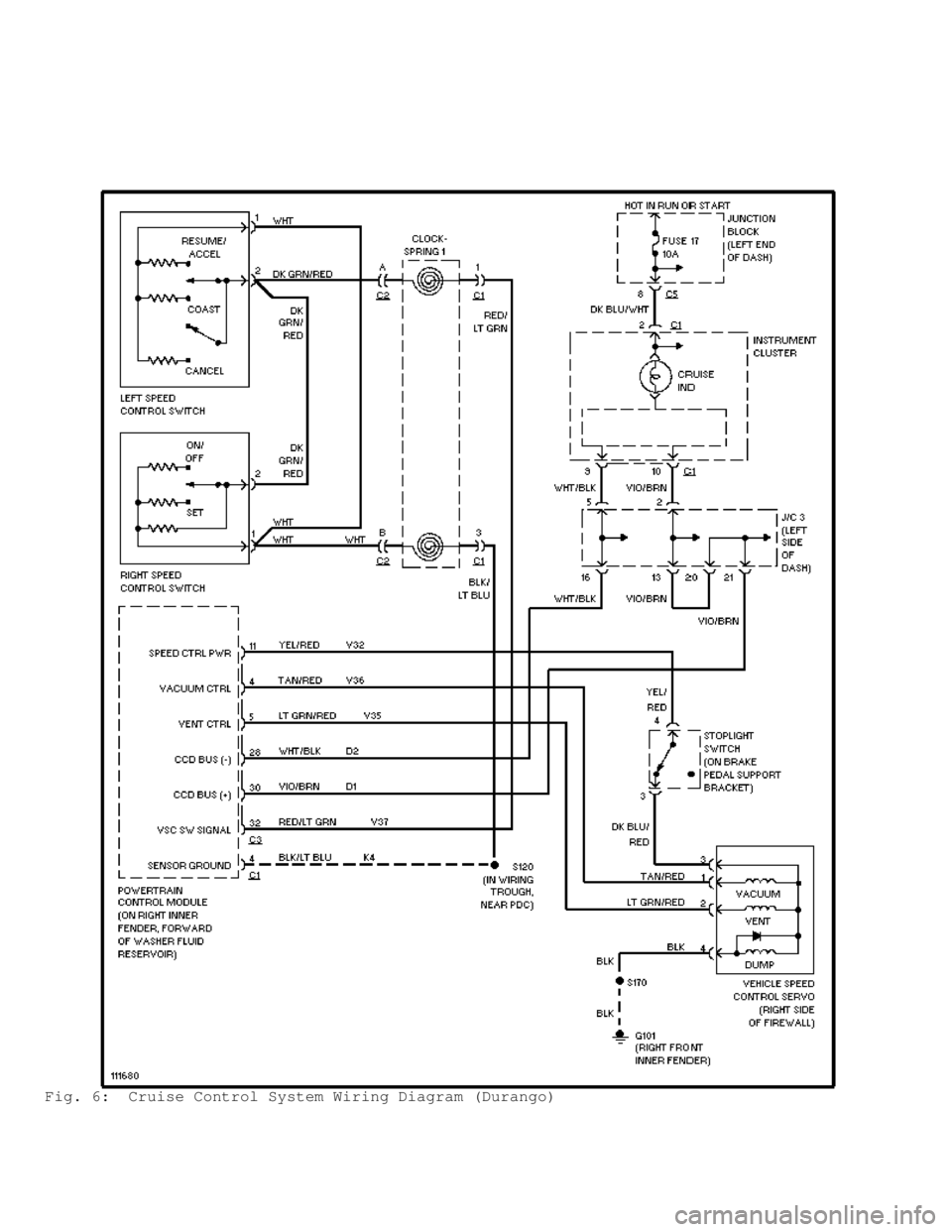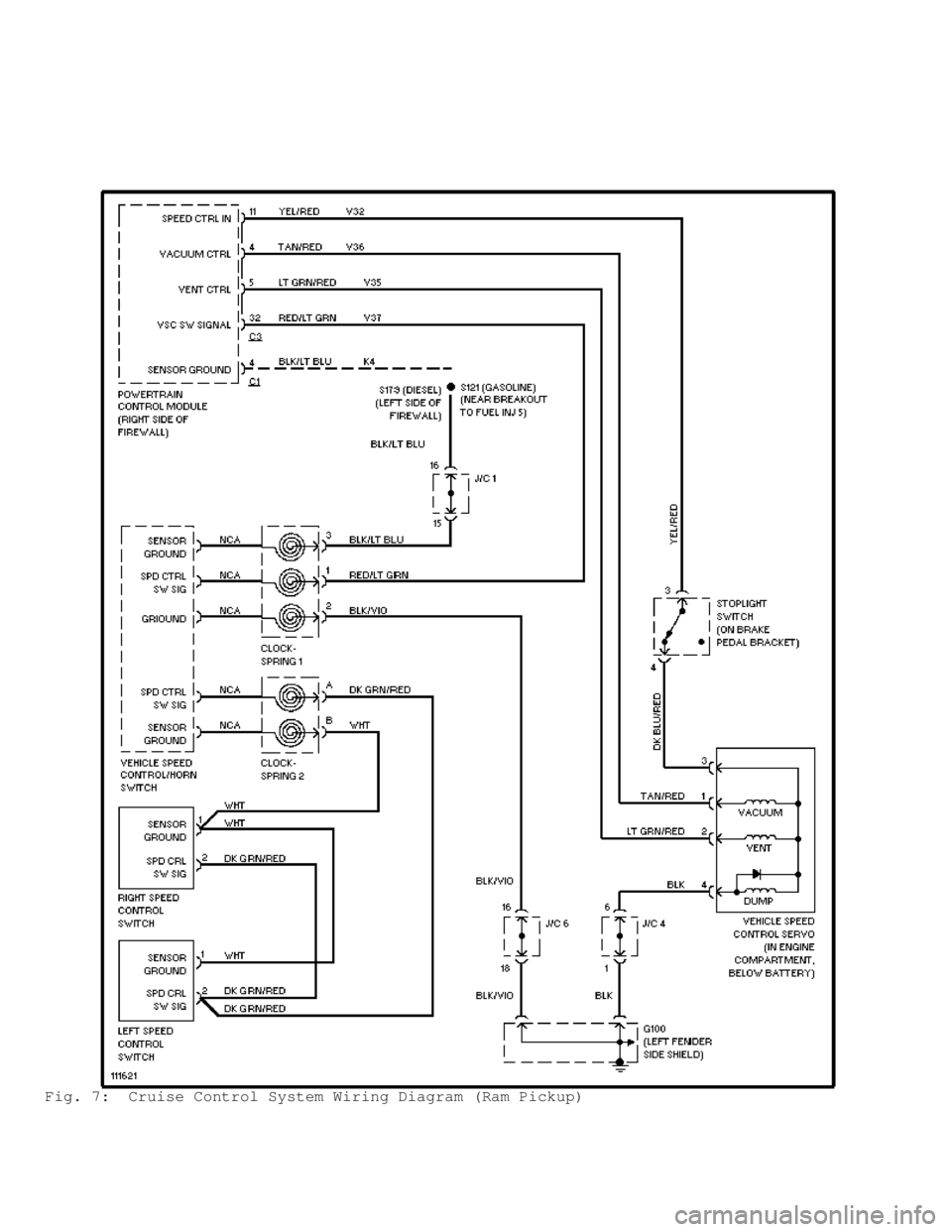1999 DODGE RAM wiring diagram
[x] Cancel search: wiring diagramPage 391 of 1691

10.4 volts. FTC P1595 will set if vacuum and vent solenoids do not
respond when actuated by PCM.
Possible Causes:
* Ground circuit open.
* S/C brake switch output circuit open.
* S/C power supply circuit open or shorted.
* S/C servo defective.
* S/C vacuum solenoid control circuit open or shorted.
* S/C vent solenoid control circuit open or shorted.
* Brake switch defective or out of adjustment.
* Defective PCM.
NOTE: For component locations, see COMPONENT LOCATIONS. For
connector terminal identification, see CONNECTOR
IDENTIFICATION. For wiring diagram, see WIRING DIAGRAMS.
1) Turn ignition on. Turn Speed Control (S/C) on. Using scan\
tool, actuate S/C vent solenoid. If speed control servo clicks, go to
next step. If S/C servo does not click, go to step 7).
2) Using scan tool, actuate S/C vacuum solenoid. If S/C servo
clicks, go to next step. If S/C servo does not click, go to step 6).
3) Turn ignition on. Using scan tool, actuate S/C vacuum
solenoid. Wiggle wiring harness between S/C servo and brake switch to
PCM while scan tool is still actuating speed control vacuum solenoid.
If wiggling did not cause an interruption of S/C servo actuation, go
to next step. If wiggling caused an interruption of S/C servo
actuation, repair wiring harness as necessary. Perform TEST VER-4A
under VERIFICATION TESTS.
4) Turn ignition off. Inspect S/C wiring and connectors.
Clean or repair as necessary. Perform TEST VER-4A under VERIFICATION
TESTS. If wiring and connectors are okay, go to next step.
5) Using scan tool, actuate S/C vent solenoid. Wiggle wiring
harness between S/C servo and brake switch to PCM while scan tool is
still actuating speed control vacuum solenoid. If wiggling did not
cause interruption of S/C servo actuation, test is complete. If
wiggling caused interruption of S/C servo actuation, repair wiring
harness as necessary. Perform TEST VER-4A under VERIFICATION TESTS.
6) Using scan tool, actuate S/C vent solenoid. Wiggle wiring
harness between S/C servo and brake switch to PCM while scan tool is
still actuating speed control vacuum solenoid. If wiggling did not
cause interruption of S/C servo actuation, go to next step. If
wiggling caused interruption of S/C servo actuation, repair wiring
harness as necessary. Perform TEST VER-4A under VERIFICATION TESTS.
NOTE: Ensure brake pedal is not depressed during the following
steps.
7) Turn ignition off. Disconnect S/C servo 4-pin connector.
Inspect all related wiring and connectors and repair as necessary.
Turn ignition on. Turn S/C switch on. Using a 12-volt test light,
probe brake switch output circuit at S/C servo connector terminal No.
3 (Dark Blue/Red wire). If test light is illuminated and bright, go to\
next step. If test light is dim or not illuminated, go to step 13).
8) Turn ignition off. Using an ohmmeter, check resistance of
ground circuit at S/C servo connector terminal No. 4 (Black wire). If
resistance is 5 ohms or more, repair open ground circuit. Perform TEST
VER-4A under VERIFICATION TESTS. If resistance is less than 5 ohms, go
to next step.
9) Disconnect PCM. Inspect connectors. Clean or repair as
necessary. Using an ohmmeter, measure resistance between ground and
S/C vacuum solenoid control circuit at S/C servo connector terminal
Page 393 of 1691

IDENTIFICATION. For wiring diagram, see WIRING DIAGRAMS.
1) Turn ignition on. Using scan tool, read S/C inputs. While
observing display, press S/C ON/OFF switch several times and leave on.
If scan tool displays S/C switch OFF and ON, go to next step. If scan
tool does not display OFF and ON, go to step 3).
2) Using scan tool, measure S/C switch voltage. While
observing display, wiggle wiring between S/C switch and PCM. If
voltage was more than 4.9 volts at any time during wiggling, repair
wiring as necessary. Perform TEST VER-4A under VERIFICATION TESTS. If
voltage was 4.9 volts or less during wiggling, test is complete.
3) Turn ignition off. Disconnect S/C ON/OFF switch. Inspect
connector. Clean or repair as necessary. Using an ohmmeter, measure
resistance of S/C switch ground circuit. If resistance is 5 ohms or
more, repair open ground circuit. Perform TEST VER-4A under
VERIFICATION TESTS. If resistance is less than 5 ohms, go to next
step.
4) Turn ignition on. Using a voltmeter, measure voltage on
S/C switch signal circuit. If voltage is more than 6 volts, repair
short to voltage. Perform TEST VER-4A under VERIFICATION TESTS. If
voltage is 6 volts or less, go to next step.
5) Turn ignition off. Disconnect PCM. Inspect connectors.
Clean or repair as necessary. Using an ohmmeter, measure resistance of
S/C switch signal circuit between ON/OFF switch connector and PCM
connector C3, terminal No. 32 (White/Light Green wire on Ram Van & Ram
Wagon; Red/Light Green wire on all other models). If resistance is
less than 5 ohms, go to next step. If resistance is 5 ohms or more, go
to step 7).
6) Using an ohmmeter, measure resistance across ON/OFF
switch. Resistance should be 20,300-20,700 ohms. If resistance is not
as specified, replace ON/OFF switch. Perform TEST VER-4A under
VERIFICATION TESTS. If resistance is as specified, replace PCM.
Perform TEST VER-4A under VERIFICATION TESTS.
7) Disconnect clockspring 5-pin connector. Clockspring 5-pin
connector is located behind lower steering column shroud. Inspect
connectors. Clean or repair as necessary. Using an ohmmeter, measure
resistance of S/C switch signal circuit between PCM connector C3,
terminal No. 32 and clockspring connector (White/Light Green wire on
Ram Van and Ram Wagon; Red/Light Green wire on all other models). If
resistance is 5 ohms or more, repair open circuit. Perform TEST VER-4A
under VERIFICATION TESTS. If resistance is less than 5 ohms, replace
clockspring. See appropriate AIR BAG RESTRAINT SYSTEMS article.
Perform TEST VER-4A under VERIFICATION TESTS.
FTC P1597: SPEED CONTROL SWITCH ALWAYS LOW
FTC P1597 will set if Speed Control (S/C) switch voltage is
less than 0.39 volts for 2 minutes when ignition is on and battery
voltage is more than 10.4 volts.
Possible Causes:
* S/C ON/OFF switch defective.
* S/C RESUME/ACCEL switch defective.
* S/C switch signal circuit shorted to ground.
* Defective PCM.
* Defective clockspring.
NOTE: For component locations, see COMPONENT LOCATIONS. For
connector terminal identification, see CONNECTOR
IDENTIFICATION. For wiring diagram, see WIRING DIAGRAMS.
1) Turn ignition on. Using scan tool, read S/C switch
Page 394 of 1691

voltage. If voltage is less than one volt, go to next step. If voltage
is one volt or more, condition to set FTC is not present at this time.
Test is complete.
2) While observing scan tool, disconnect S/C ON/OFF switch.
If S/C switch voltage changes to 5 volts, replace S/C ON/OFF switch.
Perform TEST VER-4A under VERIFICATION TESTS. If voltage does not
change to 5 volts, go to next step.
3) While observing scan tool, disconnect S/C RESUME/ACCEL
switch. If S/C switch voltage changes to 5 volts, replace S/C
RESUME/ACCEL switch. Perform TEST VER-4A under VERIFICATION TESTS. If
voltage does not change to 5 volts, go to next step.
4) Turn ignition off. Ensure both S/C switches are still
disconnected. Using an ohmmeter, check resistance between S/C switch
connector terminals (S/C switch signal circuit and S/C switch ground
circuit). If resistance is less than 5 ohms, repair short circuit.
Perform TEST VER- 4A under VERIFICATION TESTS. If resistance is 5 ohms
or more, go to next step.
5) Disconnect clockspring 4-pin connector. Clockspring 4-pin
connector is located behind steering wheel. Inspect connector. Clean
or repair as necessary. Using an ohmmeter, check resistance between
ground and S/C switch signal circuit at clockspring connector (Dark
Green/Red wire on all models except Ram Van and Ram Wagon; wire color
is not available for Ram Van and Ram Wagon). If resistance is less
than 5 ohms, repair short to ground. Perform TEST VER-4A under
VERIFICATION TESTS. If resistance is 5 ohms or more, go to next step.
6) Disconnect PCM. Inspect connectors. Clean or repair as
necessary. Using an ohmmeter, check resistance between ground and S/C
switch signal circuit at either S/C switch connector (Dark Green/Red
wire on all models except Ram Van and Ram Wagon; wire color is not
available for Ram Van and Ram Wagon). If resistance is less than 5
ohms, repair short to ground. Perform TEST VER-4A under VERIFICATION
TESTS. If resistance is 5 ohms or more, replace PCM. Perform TEST VER-
4A under VERIFICATION TESTS.
FTC P1683: SPEED CONTROL POWER RELAY CIRCUIT
FTC P1683 will set if Speed Control (S/C) power supply
circuit is open or shorted when S/C is turned on.
Possible Causes:
* Brake switch out of adjustment.
* S/C brake switch output circuit open or shorted.
* Defective S/C servo.
* Defective brake switch.
* S/C vacuum or vent solenoid control circuits open or
shorted.
* Defective PCM.
* Ground circuit open.
* S/C power supply circuit open.
NOTE: For component locations, see COMPONENT LOCATIONS. For
connector terminal identification, see CONNECTOR
IDENTIFICATION. For wiring diagram, see WIRING DIAGRAMS.
NOTE: Ensure brake pedal is not depressed during the following
steps.
1) Turn ignition off. Disconnect S/C servo connector. Inspect
connector. Clean or repair as necessary. Turn ignition on. Using scan
tool, actuate S/C relay. Using a 12-volt test light, probe S/C brake
switch output circuit at S/C servo connector terminal No. 3 (Dark
Blue/Red wire). If test light is illuminated and bright, go to next
Page 396 of 1691

* PNP switch defective.
* PNP switch sense circuit open or shorted.
* PNP switch stuck.
* PCM defective.
NOTE: For component locations, see COMPONENT LOCATIONS. For
connector terminal identification, see CONNECTOR
IDENTIFICATION. For wiring diagram, see WIRING DIAGRAMS.
1) Turn ignition on. Using scan tool, read PNP switch state.
While observing scan tool, move gear selector between Park and
Reverse. If scan tool displays P/N and D/R, go to next step. If scan
tool does not display P/N and D/R, go to step 3).
2) Turn ignition off. Inspect wiring and connectors related
to PNP switch. Repair as necessary. Perform TEST VER-5A under
VERIFICATION TESTS. If wiring and connectors are okay, condition to
set FTC is not present at this time. Test is complete. Use freeze
frame data to determine conditions when FTC was set.
3) Turn ignition off. Disconnect PCM. Inspect connectors.
Clean or repair as necessary. Using an ohmmeter, check resistance
between ground and PNP switch sense circuit at PCM connector C1,
terminal No. 6 (Black/White wire). While observing ohmmeter, move gear\
selector from Park to Reverse and back to Park. If resistance switched
from less than 10 ohms to more than 10 ohms, replace PCM. Perform TEST
VER-5A under VERIFICATION TESTS. If resistance was less than 10 ohms
at all times, go to next step. If resistance was more than 10 ohms at
all times, go to step 5).
4) Disconnect PNP switch. Inspect connectors. Clean or repair
as necessary. Using an ohmmeter, check resistance between ground and
PNP switch sense circuit. If resistance is less than 5 ohms, repair
short to ground. Perform TEST VER-5A under VERIFICATION TESTS. If
resistance is 5 ohms or more, repair or replace stuck PNP switch.
Perform TEST VER-5A under VERIFICATION TESTS.
5) Using an ohmmeter, check resistance of PNP switch circuit
between PNP switch connector and PCM connector C1, terminal No. 6
(Black/White wire). If resistance is 5 ohms or more, repair open
circuit. Perform TEST VER-5A under VERIFICATION TESTS. If resistance
is less than 5 ohms, replace PNP switch. Perform TEST VER-5A under
VERIFICATION TESTS.
SYSTEM TESTS
NOTE: For component locations, See COMPONENT LOCATIONS. For
connector terminal identification, see CONNECTOR
IDENTIFICATION. For wiring diagram, see WIRING DIAGRAMS.
CHECKING SPEED CONTROL OPERATION
NOTE: Perform this test only if there are no DTCs.
1) Turn ignition on. Using scan tool, monitor S/C switch
inputs. Press S/C ON/OFF switch several times. If scan tool displays
speed control switch on and off, go to next step. If scan tool does
not display speed control switch on and off, go to NTC-3: SPEED
CONTROL ON/OFF SWITCH.
2) While observing scan tool, press RESUME/ACCEL switch
several times. If scan tool displays RESUME/ACCEL switch PRESSED and
RELEASED, go to next step. If scan tool does not display PRESSED and
RELEASED, go to NTC-4: SPEED CONTROL RESUME/ACCEL SWITCH.
3) While observing scan tool, press brake pedal several
times. If scan tool displays brake pedal PRESSED and RELEASED, go to
Page 402 of 1691

Fully depress brake pedal and rotate brake switch
counterclockwise approximately 30 degrees. Remove brake switch from
bracket. Depress lock tabs holding brake switch mounting bracket and
separate harness connector from brake switch.
Installation
1) Before installing brake switch, reset adjustable plunger
by pulling on plunger head until plunger reaches end of travel.
Connect harness connector to brake switch. Depress brake pedal and
insert brake switch into keyed hole in mounting bracket. Rotate brake
switch clockwise into locked position.
2) Gently pull back on brake pedal until pedal will go no
further. This causes the brake switch plunger to ratchet backward to
the correct position. No further adjustment is required.
SPEED CONTROL SERVO
Removal (Except Ram Van & Ram Wagon)
1) Disconnect negative battery cable. Disconnect electrical
connector and vacuum hose from servo. Using finger pressure only, push
servo cable connector from throttle body bellcrank pin. DO NOT pull
cable connector perpendicular to bellcrank.
2) Remove 2 servo cable mounting nuts. Pull servo cable
sleeve away from mounting bracket to expose cable retaining clip.
Remove retaining clip. Remove servo.
Removal (Ram Van & Ram Wagon)
1) Disconnect negative battery cable. Remove engine cover.
Remove air cleaner assembly. Using finger pressure only, push servo
cable connector from throttle body bellcrank pin. DO NOT pull cable
connector perpendicular to bellcrank.
2) Remove right headlight assembly. Disconnect vacuum hose
and electrical connector at servo. Remove 2 servo mounting bracket
bolts. Remove 2 servo cable mounting nuts. Pull servo cable sleeve
away from mounting bracket to expose cable retaining clip. Remove
retaining clip. Remove servo.
Installation (All Models)
With throttle in full open position, align hole in speed
control cable sleeve with hole in servo pin. Install retaining clip.
To complete installation, reverse removal procedure. Tighten mounting
bolts/nuts to 75 INCH lbs. (8.5 N.m).
SPEED CONTROL SWITCHES
Removal & Installation
Turn ignition off. Disconnect negative battery cable. Wait 2
minutes for air bag system to discharge reserve voltage. Remove 2
screws holding air bag assembly to steering column. Separate air bag
assembly from steering column and disconnect air bag, horn and speed
control switch connectors. Remove screws securing speed control switch
to air bag assembly. Separate speed control switch from air bag
assembly. To install, reverse removal procedure.
WIRING DIAGRAMS
Page 403 of 1691

Fig. 5: Cruise Control System Wiring Diagram (Dakota)
Page 404 of 1691

Fig. 6: Cruise Control System Wiring Diagram (Durango)
Page 405 of 1691

Fig. 7: Cruise Control System Wiring Diagram (Ram Pickup)